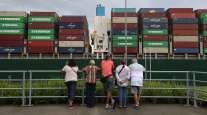Trump Slaps Tariffs on $50 Billion Worth of Chinese Goods

President Donald Trump took his boldest step to level the economic playing field with China, ordering sweeping tariffs on Chinese goods in a move that could escalate already-tense trade relations between the world’s two biggest economies.
The president instructed U.S. Trade Representative Robert Lighthizer to levy tariffs on at least $50 billion in Chinese imports. Trump signed an executive memo issuing the instructions on March 22 at the White House. Within 15 days, USTR will come up with a proposed list of products that will face higher tariffs.
“This has been long in the making,” Trump said, adding that the tariffs could affect as much as $60 billion in goods. “We have a tremendous intellectual property theft situation going on” with China affecting hundreds of billions of dollars in trade each year, he said.
As he signed the tariffs order, Trump told reporters, “This is the first of many.”
RELATED: Dozens of US business groups warn Trump against China tariffs
Trump also directed Treasury Secretary Steven Mnuchin to propose new investment restrictions on Chinese companies within 60 days to safeguard technologies the U.S. views as strategic, said senior White House economic adviser Everett Eissenstat.
Policy makers across the world are warning of a brewing trade war that could undermine the broadest global recovery in years. U.S. stocks fell sharply early March 22 amid worries that the U.S. action could provoke a stern response from China, with the S&P 500 down 1.3% at 1:18 p.m. New York time. Meanwhile, business groups representing companies ranging from Walmart Inc. to Amazon.com Inc. are warning U.S. tariffs could raise prices for consumers and sideswipe stock prices.
Fed Warnings
Even central banks, which normally stay above the fray of trade spats, are weighing in. “A number of participants reported about their conversations with business leaders around the country and reported that trade policy has become a concern,” Federal Reserve Chairman Jerome Powell said this week, while cautioning that trade issues haven’t changed the Fed’s outlook. The Bank of England warned March 22 that increased protectionism could have a “significant negative impact” on global growth.
RELATED: Cracks are starting to appear in the global economy’s momentum
The Trump administration is framing the move as a major turning point in U.S.-China relations. It followed a seven-month investigation by USTR into allegations China violates U.S. intellectual property, under the seldom-used section 301 of the 1974 Trade Act. The U.S. concluded China engages in a range of violations, including policies that force American companies to transfer technology and the accessing of trade secrets through hacking, said Eissenstat.
Trump tried to make it clear he wasn’t trying to provoke China.
“I view them as a friend. I have tremendous respect for President Xi,” Trump said. But, the U.S.’s trade deficit with China is “the largest deficit in the history of our world,” he said.
The president’s action brought rare praise from Senate Democratic Leader Chuck Schumer, ordinarily a foe of the administration.
The president is “exactly right” to pursue the tariffs, Schumer said. “I want to give him a big pat on the back,” the New York senator added, “I’m very pleased that this administration is taking strong action to get a better deal on China.”
RELATED: US trade gap widens to post-recession high
Trump’s actions represent a “seismic shift from an era dating back to Nixon and Kissinger, where we had as a government viewed China in terms of economic engagement,” White House trade adviser Peter Navarro told reporters on March 22. “That process has failed.”
“The problem is that with the Chinese in this case, talk is not cheap. It has been very expensive for America,” said Navarro. “Finally the president decided that we needed to move forward.”
Commerce Secretary Wilbur Ross predicted a strong stand on trade would bring concessions without escalating into a broader conflict. ‘We will end up negotiating these things rather than fighting over them, in my view,” Ross said.
Before the tariffs become final, there will be a 30-day comment period, the White House said. Trump also directed his officials to pursue a World Trade Organization complaint against China for discriminatory licensing practices.
It will be Trump’s first trade action directly aimed at China, which he has blamed for the hollowing out of the American manufacturing sector and the loss of U.S. jobs. The Trump administration is also increasingly signaling it will exclude allies such as the European Union and Brazil from tariffs on steel and aluminum that take effect March 23, suggesting the U.S. is more interested in raising pressure on China, the world’s biggest producer of both commodities.
China Warning
China’s Ministry of Commerce has cautioned against the U.S. taking measures “detrimental to both sides.” The nation strongly opposes such unilateral and protectionist action, and will take “all necessary measures” to firmly defend its interests, the ministry said in a statement on its website.
“If Trump really signs the order, that is a declaration of trade war with China,” said Wei Jianguo, former vice commerce minister and now an executive deputy director of the China Center for International Economic Exchanges, a government-linked think tank.
What Bloomberg Economists Say
“$50 billion in tariffs against China, if that is what the U.S. moves ahead with, is serious money. Even so, the impact on China’s GDP would still be just a fraction of a % off the growth rate,” Tom Orlik, chief Asia economist for Bloomberg Economics, wrote in a note. “The greater risk comes to China’s long-term development trajectory, if the rise of economic nationalism impedes their march up the value chain.”
“China is not afraid, nor will it dodge a trade war,” Wei said. “We have plenty of measures to fight back, in areas of automobile imports, soybean, aircraft and chips. On the other hand, Trump should know that this is a very bad idea, and there will be no winner, and there will be no good outcome for both nations.”
Chinese Premier Li Keqiang said this week that the nation will further open its economy, including the manufacturing sector, and pledged to lower import tariffs and cut taxes. In opening manufacturing further, China won’t force foreign companies to transfer technology to domestic ones and will protect intellectual property, he said.
Bloomberg Economics estimates a global trade conflagration could wipe $470 billion off the world economy by 2020.




